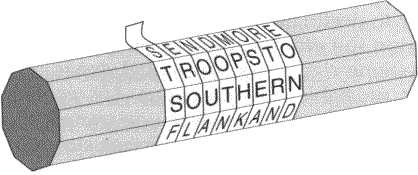Simple Transposition Ciphers
Transposition Ciphers are a bit different to Substitution Ciphers. Whereas Substitution ciphers replace each letter with a different letter or symbol to produce the ciphertext, in a Transposition cipher, the letters are just moved around.
The letters or words of the plaintext are reordered in some way, fixed by a given rule (the key).
One example of a transposition cipher, is to reverse the order of the letters in a plaintext. So "a simple example" becomes "ELPMAXE ELPMIS A". Another, similar, way to encrypt a message would be to reverse the letters of each word, but not the order in which the words are written. In this case "a simple example" becomes "A ELPMIS ELPMAXE". Both of these are available in the activity at the bottom of the page.
Another type of transposition cipher is the Scytale, which was an encryption device used by the Ancient Greeks and Spartans. It consisted of a polygonal rod or cylinder, around which was wrapped a piece of parchment. The sender would write the message along the faces of the rod as seen in the image below. When the parchment is removed from the Scytale, it leaves a nonsensical message going down the strip (in the case below it would read "STSF...").
When the message is received, it is wrapped around a rod of the same size and shape as the original, to reveal the original message. Clearly, you just need to get a rod of the same size, or try out a few different ones to break this code. However, its importance lies in the fact that it is one of the first uses of tools in Crytpography.
One important strength of transposition ciphers is that they are not susceptible to frequency analysis, since we have not changed the symbols for each letter. If there are 14 "e" in the plaintext, then there will be 14 "E" in the ciphertext, just in different positions. However, there are still methods that cryptanalysts can use to break intercepted messages.
To make transposition ciphers such as the reverse ciphers above a bit more secure, it is usual to remove all punctuation marks from the plaintext first. It is quite often the case that all spaces are also removed.
In this section we will look at the following Transposition Ciphers:
Finally in this section we will look at how we can combine Transposition Ciphers with Monoalphabetic Substitution Ciphers to further increase security.
- Rail Fence Cipher
- Route Cipher
- Columnar Transposition Cipher
- Myszkowski Transposition Cipher
- Permutation Cipher
Finally in this section we will look at how we can combine Transposition Ciphers with Monoalphabetic Substitution Ciphers to further increase security.
